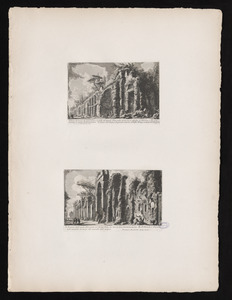Boston Public Library
The Antonio Cardinal Tosti Collection
Antonio Cardinal Tosti (1766-1866) was appointed as Cardinal-Priest of San Pietro in Montorio in 1839 and later served as the Librarian of the Vatican Library (1860-1866) until his death. He assembled a large collection of prints that was particularly strong in the works of Old Masters and Italian artists of the 16th through the 18th centuries, and he patronized the work of many of his contemporary Italian printmakers. Many of the important prints in the collection are what art historians term <em>reproductive</em> prints: engravings made from original paintings or frescoes by other artists. In the 19th century, this was the only means of learning about the art of Europe for people who could not travel. Michelangelo’s frescoes in the Sistine Chapel are reproduced along with the works of Raphael, Rubens, Giotto, Poussin, and many others. The collection included more than five thousand prints, most bound in oversize portfolios. Among the highlights are the twenty-nine volumes of the etchings of Giovanni Battista Piranesi (1720-1788).
The Tosti Collection came to Boston Public Library through the generosity of Thomas Gold Appleton (1812-1884). Scion of a wealthy Boston family, Appleton was a writer, patron of the arts, and one of the original group of Trustees of the Boston Public Library. He was among the first to present important collections of visual materials to the library, including his 1855 gift of a nearly complete set of John James Audubon’s Birds of America. During a trip to Rome in 1869, Appleton learned that the large and important collection of engravings formed by Cardinal Tosti was about to be sold. He purchased the entire collection and presented it to the Trustees.
The Trustee’s Annual Report for 1869 described the munificent gift as forming “a cabinet of instruction of a character heretofore inaccessible to a large portion of our population, who will recognize with pleasure the wise foresight which prompted a public benefactor to assist in the art-culture, and to contribute so greatly to their enjoyment.” Later in the same report the gift is referred to as the most important benefaction of the year.
Work began immediately to catalog the collection and, beginning in 1873, Boston Public Library published a list in three parts containing brief descriptions of the prints. Once the collection had been cataloged, it was made available in the library’s Bates Hall between the hours of 9am and 12pm. Annual reports record the yearly usage of the collection between 1873 and 1878: during those five years more than three thousand members of the public examined works from the collection.
Critical funding to support long-term preservation of and enhanced public access to Boston Public Library collections, including this one, was provided by the Associates of the Boston Public Library.
The Tosti Collection came to Boston Public Library through the generosity of Thomas Gold Appleton (1812-1884). Scion of a wealthy Boston family, Appleton was a writer, patron of the arts, and one of the original group of Trustees of the Boston Public Library. He was among the first to present important collections of visual materials to the library, including his 1855 gift of a nearly complete set of John James Audubon’s Birds of America. During a trip to Rome in 1869, Appleton learned that the large and important collection of engravings formed by Cardinal Tosti was about to be sold. He purchased the entire collection and presented it to the Trustees.
The Trustee’s Annual Report for 1869 described the munificent gift as forming “a cabinet of instruction of a character heretofore inaccessible to a large portion of our population, who will recognize with pleasure the wise foresight which prompted a public benefactor to assist in the art-culture, and to contribute so greatly to their enjoyment.” Later in the same report the gift is referred to as the most important benefaction of the year.
Work began immediately to catalog the collection and, beginning in 1873, Boston Public Library published a list in three parts containing brief descriptions of the prints. Once the collection had been cataloged, it was made available in the library’s Bates Hall between the hours of 9am and 12pm. Annual reports record the yearly usage of the collection between 1873 and 1878: during those five years more than three thousand members of the public examined works from the collection.
Critical funding to support long-term preservation of and enhanced public access to Boston Public Library collections, including this one, was provided by the Associates of the Boston Public Library.





